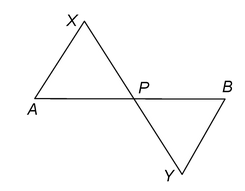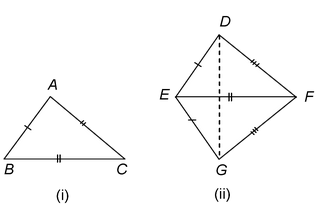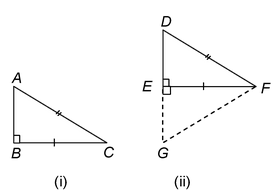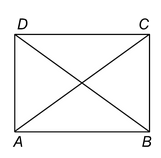Types of triangles
Triangles of Class 9
TYPES OF TRIANGLES:
(i) On the basis of sides we have three types of triangles:
(A)Scalene triangle : A triangle whose no two sides are equal is called a scalene triangle.
(B) Isosceles triangle - A triangle having two sides equal is called an isosceles triangle.
(C) Equilateral triangle - A triangle in which all sides are equal is called an equilateral triangle.
(ii) On the basis of angles we have three types of triangles:
(A) Right triangle - A triangle in which any one angle is right angle (=90o) is called right triangle.
(B) Acute triangle - A triangle in which all angles are acute (>90o) is called an acute triangle.
(C) Obtuse triangle - A triangle in which any one angle is obtuse (<90o) is called an obtuse triangle.
CONGRUENT FIGURES
The figures are called congruent if they have same shape and same size. In order words, two figures are called congruent if they are having equal length, width and height.
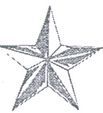

Fig. (i) Fig. (ii)
In the above figures {fig. (i) and fig. (ii)} both are equal in length, width and height, so these are congruent figures.
(a) Congruent Triangles :
Two triangles are congruent if and only if one of them can be made to superimposed on the other, so to cover it exactly.

If two triangles ΔABC and ΔDEF are congruent then there exist a one to one correspondence between their vertices and sides. i.e. we get following six equalities.
∠A = ∠D, ∠B = ∠E, ∠C = ∠F and AB = DE, BC = EF, AC = DF.
If two ΔABC &ΔDEF are congruent under A ⇔ D, B ⇔ E, C ⇔ F one to one correspondence then we write ΔABC≅ΔDEF we cannot write as ΔABC≅ΔDFE of ΔABC≅ΔEDF or in other forms because ΔABC≅ΔDFE have following one-one correspondence A ⇔ D, B ⇔ F, C ⇔ E.
Hence we can say that “two triangles are congruent if and only if there exists a one-one correspondence between their vertices such that the corresponding sides and the corresponding angles of the two triangles are equal.
(b) Sufficient Conditions for Congruence of two Triangles:
SAS Congruence Criterion:
Two triangles are congruent if two sides and the included angle of one are equal to the corresponding sides and the included angle of the other triangle.
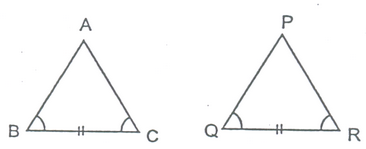
Ex.1 In figure O is the mid-point of AB and CD. Prove that
(i) ΔAOC ≅ΔBOD (ii) AC = BD and (iii) AC || BD
Sol: In Δs AOC and BOD, we have
AO = OB [ O is the mid-point of AB]
O is the mid-point of AB]
∠AOC = ∠BOD [Vertically opposite angles]
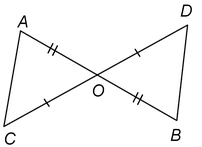
and, CO = OD [ O is the mid-point of CD]
O is the mid-point of CD]
So, by SAS congruence criterion, we have
ΔAOC≅ΔBOD
⇒AC = BD and, ∠CAO = ∠DBO
[Corresponding parts of congruent triangles are equal]
Now, AC and BD are two lines intersected by a transversal AB such that
∠CAO = ∠DBO, i.e. alternate angles are equal. Therefore, AC || BD
Ex.2 In figure, it is given that AE = AD and BD = CE. Prove that ΔAEB ≅ΔADC
Solution: We have,
|
AE = AD ...(i) CE = BD ...(ii) Adding equation (i) and (ii) we have ⇒AE + CE = AD + BD ⇒ AC = AB ...(iii) Now, in Δs AEB and ADC, we have AE = AD [Given] |
|
∠EAB = ∠DAC [Common]
and, AC = AB [From (iii)]
So, by SAS criterion of congruence, we have
ΔAEB≅ΔADC
ANGLE-SIDE-ANGLE (ASA) CONGRUENCE CRITERION:
Two triangles are congruent if two angles and the included side of one triangle are equal to the corresponding two angles and the included side of the other triangle.
Given : Two Δs ABC and DEF such that ∠B = ∠E, ∠C = ∠F and BC = EF
To prove :ΔABC≅ΔDEF
Proof : There are three possibilities
Case I : When AB = DE:
|
In this case, we have AB = DE ∠B = ∠E and, BC = EF So, by SAS criterion of congruence, we have |
|
ΔABC≅ΔDEF
Case II : When BA<ED
In this case take a point G on ED such that EG = BA. Join GF.
|
Now, in Δs ABC and GEF, we have BA = GE [Assumed] ∠B = ∠E [Given] and, BC = EF [Given] So, by SAS criterion of congruence, we have |
|
ΔABC≅ΔGEF
⇒ ∠ACB = ∠GFE [cpct]
But, ∠ACB = ∠DFE [Given]
∴ ∠GFE = ∠DFE
This is possible only when ray FG coincides with ray FD or G coincides with D.
Therefore, BA must be equal to ED.
Thus, in Δs ABC and DEF, we have
AB = DE [As proved above]
∠B = ∠E [Given]
and, BC = EF [Given]
So, by SAS criterion of congruence, we have
|
ΔABC≅ΔDEF Case III :when BA>ED In this case take a point G on ED produced such that EG = BA. Join GF. Now, proceeding as in case II, we prove that ΔABC≅ΔDEF |
|
Hence, in all the three case, we have ΔABC≅ΔDEF
ANGLE- ANGLE-SIDE (AAS) CONGRUENCE CRITERION
If any two angles and a non-included side of one triangle are equal to the corresponding angles and side of another triangle, then the two triangles are congruent.
|
Given : Two Δs ABC and DEF such that ∠A = ∠D, ∠B = ∠E, BC = EF To prove :ΔABC≅DEF Proof : We have, ∠A = ∠D, and ∠B = ∠E |
|
⇒ ∠A + ∠B = ∠D + ∠E
⇒ 180°−∠C = 180°−∠F [Angle sum property]
⇒ ∠C = ∠F …(i)
Thus, in Δs ABC and DEF, we have
∠A= ∠D, ∠B = ∠E and ∠C = ∠F
Now, in ΔABC and ΔDEF, we have
∠B = ∠E [Given]
BC = EF [Given]
and,∠C = ∠F [From (i)]
So, by ASA criterion of congruence, ΔABC ≅ΔDEF
THEOREM:
Angles opposite to equal sides of an isosceles triangle are equal.
|
Given: An isosceles triangle ABC in which AB = AC. To prove:∠B = ∠C. Construction: Draw the bisector of ∠A and let D be the point of intersection of this bisector of ∠A and BC. |
|
Proof : In ΔBAD and ΔCAD
AB = AC [Given]
∠BAD = ∠CAD [By construction]
AD = AD [Common]
ΔBAD≅ΔCAD [By SAS Congruency]
∠ABD = ∠ACD [cpct]
∴∠B = ∠C
THEOREM:
If two angles of a triangle are equal, then sides opposite to them are also equal.
|
Given :AΔABC in which ∠B = ∠C To prove :AC = AB Construction: Draw the bisector of ∠A and let it meet BC at D. Proof : In Δs ABD and ACD, we have |
|
∠B = ∠C [Given]
∠BAD = ∠CAD [By construction]
AD = AD [Common]
So, by SAS criterion of congruence, we have
ΔABD≅ΔACD
⇒ AB = AC [cpct]
Ex.3 In figure, diagonal AC of a quadrilateral ABCD bisects the angles A and C. Prove that AB = AD and CB = CD.
Solution: Since diagonal AC bisects the angles A and C.
|
∴ ∠BAC = ∠DAC and ∠BCA = ∠DCA In triangles ABC and ADC, we have ∠BAC = ∠DAC [Given] ∠BCA = ∠DCA [Given] and, AC = AC [Common] So, by ASA congruence criterion, we have ΔBAC≅ΔDAC ⇒ BA = DA and CB = CD [cpct] |
|
Ex.4 AB is a line segment, AX and BY are two equal segment drawn on opposite sides of line AB such that AX || BY. If AB and XY intersect each other at P, prove that
(i) ΔAPX ≅ΔBPY (ii) AB and XY bisect each other
Solution: Since AX || BY and transversal AB intersects them at A and B respectively. Therefore,
∠BAX = ∠ABY [Alternate angles]
Similarly, we have ∠AXP = ∠BYP [Alternate angles]
|
Thus, in triangles PAX and PBY, we have ∠PAX = ∠PBY [Alternate angles] ∠AXP = ∠PBY [Alternate angles] and, AX = BY [Given] So, by ASA congruence criterion, we have ΔAPX≅ΔBPY |
|
⇒ AP = BP and PX = PY [cpct]
Hence, AB and XY bisect each other at P.
SIDE-SIDE-SIDE(SSS) CONGRUENCE CRITERION
Two triangles are congruent if the three sides of one triangle are equal to the corresponding three sides of the other triangle.
|
Given : Two Δs ABC and DEF such that AB = DE, BC = EF and AC = DF. To prove:ΔABC≅ΔDEF Construction: Suppose BC is the longest side. Draw EG such that ∠FEG = ∠ABC and EG = AB. Join GF and GD. Proof:In Δs ABC and ΔGEF, we have |
|
BC = EF [Given]
AB = GE [By construction]
and, ∠ABC = ∠FEG [By construction]
So, by SAS criterion of congruence, we have
ΔABC≅ΔGEF
⇒ ∠A = ∠Gand AC = GF [c.p.c.t.]
Now, AB = DE and AB = GE …(i)
⇒ DE = GE
Similarly, AC = DF and AC = GF …(ii)
⇒ DF = GF
In ΔEGD, we have
DE = GE [From (i)]
⇒ ∠EDG = ∠EGD …(iii) [Angles opp. to equal side]
In ΔFGD, we have
DF = GF [From (ii)]
⇒ ∠FDG = ∠FGD …(iv) [Angles opp. to equal side]
From (iii) and (iv), we have
∠EDG + ∠FDG = ∠EGD + ∠FGD
⇒ ∠D = ∠G
But, ∠G = ∠A [Proved above]
∴ ∠A = ∠D …(v)
Thus, in Δs ABC and DEF, we have
AB = DE [Given]
∠A = ∠D [From (v)]
and, AC = DF [Given]
So, by SAS criterion of congruence, we have
ΔABC≅ΔDEF
RIGHT ANGLE-HYPOTENUSE-SIDE (RHS) CONGRUENCE CRITERION
Two right triangles are congruent if the hypotenuse and one side of one triangle are respectively equal to the hypotenuse and one side of the other triangle.
Given : Two right angles ABC and DEF in which ∠B = ∠E = 90°, AC = DF, BC = EF
To prove :ΔABC≅ΔDEF
Construction : Produce DE to G so that EG = AB. Join GF
|
Proof :In Δs ABC and ΔGEF, we have AB = GE [By construction] ∠ABC = ∠FEG [Both 90º] and,BC = EF [Given] So, by SAS criterion of congruence, we have ΔABC≅ΔGEF |
|
⇒ ∠A = ∠G …(i)
AC = GF [cpct] …(ii)
Now, AC = GF [From (ii)]
and, AC = DF [Given]
∴ DF = GF
⇒ ∠D = ∠G [Angles opposite to equal sides] ...(iii)
From (i) and (iii), we get
∠A = ∠D …(iv)
Thus, in Δs ABC and DEF, we have
∠A = ∠D [From (iv)]
∠B = ∠E [Both 90º]
⇒ ∠A + ∠B = ∠D + ∠E
⇒ 180°−∠C = 180°−F [Angle sum property]
⇒ ∠C = ∠F …(v)
Now, in Δs ABC and DEF, we have
BC = EF [Given]
∠C = ∠F [From (v)]
and, AC = DF
So, by SAS criterion of congruence, we have
ΔABC≅ΔDEF
Ex.5 ABCD is a parallelogram, if the two diagonals are equal, find the measure of ∠ABC.
Solution: Since ABCD is a parallelogram. Therefore,
AB = CD and AD = BC [ Opp. sides of a parallelogram are equal]
Opp. sides of a parallelogram are equal]
|
Thus, in Δs ABD and ACB, we have AD = BC [Proved above] BD = AC [Given] and,AB = AB [Common] So, by SSS criterion of congruence, we have ΔABD≅ΔACB |
|
⇒ ∠BAD = ∠ABC [cpct] …(i)
Now, AD || BC and transversal AB intersects them at A and B respectively.
∴ ∠BAD + ∠ABC = 180° [Cons. Interior angles are supplementary]
⇒ ∠ABC + ∠ABC = 180° [From (i)]
⇒ 2∠ABC = 180°
⇒ ∠ABC = 90°
Hence, the measure of ∠ABC is 90°.
Ex.6 If two isosceles triangles have a common base, prove that the line joining their vertices bisects them at right angles.
Solution: Given: Two isosceles triangles ABC and DBC having the common base BC such that AB = AC and DB = DC.
To Prove:AD bisects BC at right angle.
Proof: In Δs ABD and ACD, we have
AB = AC [Given]
BD = CD [Given]
and,AD = AD [Common]
So, by SSS criterion of congruence, we have
ΔABD≅ΔACD
⇒∠1 = ∠2 …(i) [cpct]
∴ In ΔABE and ΔACE, we have
AB = AC [Given]
∠1 = ∠2 [From (i)]
and,AE = AE [Common]
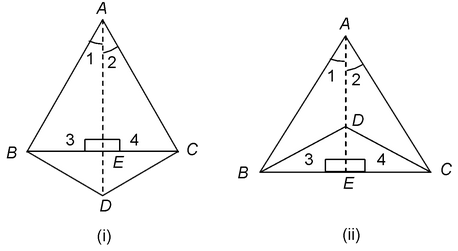
So, by SAS criterion of congruence, we have
ΔABE≅ΔACE
⇒ BE = CE [cpct]
and, ∠3 = ∠4 [cpct]
But, ∠3 + ∠4 = 180° [Linear pair]
⇒ 2∠3 = 180° [ ∠3 = ∠4]
∠3 = ∠4]
⇒ ∠3 = 90°
∴ ∠3 = ∠4 = 90°
Hence, AD bisects BC at right angles.
Ex.7 ABC is a triangle in which altitudes BE and CF to sides AC and AB are equal. Show that
(i) 
(ii) AB = AC; i.e. ABC is an isosceles triangle.
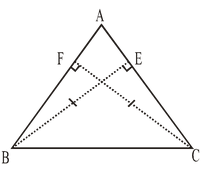
Given:
In ΔABC altitudes BE = CF
To prove:(i) 
(ii) AB = AC ; i.e. ABC is an isosceles triangle.
Solution:
(i)In ΔABE and Δ ACF, we have
BE = CF[Given]
∠AEB = ∠AFC = 90o [ BE and CF are altitudes: Given]
and ∠A = ∠A[Common]
 [By AAS congruence rule] Proved. (ii)
[By AAS congruence rule] Proved. (ii)
 [By proof]
[By proof]
∴ AB = AC[By CPCT]
Hence, ABC is an isosceles triangle.
Ex.8 ABC is a right angled triangle in which ∠A = 90o and AB = AC. Find ∠B and ∠C.

Given:
ABC is a right angled triangle in which ∠A = 90o and AB = AC.
To find:
∠B and ∠C
Solution:
In right angled triangle ABC, we have
AB = AC[Given]
∴∠B = ∠C
[Angles opposite to equal sides of a triangle are equal] ....(i)
Now, ∠A + ∠B + ∠C = 180o[Angles sum property of a Δ]
⇒ 90o + ∠B + ∠B = 180o[From (i)
∠B = ∠C]
=> 2∠B = 180o – 90o⇒ 2∠B = 90o
=>∠B = 
Hence, ∠B = ∠C = 45o
Ex.9 BE and CF are two equal altitudes of a triangle ABC. Prove that the triangle ABC is isosceles.
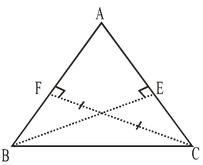
Given:
BE and CF are two equal altitudes of a triangle ABC, i.e., BE = CF
and ∠AEB = ∠AFC = 90o
To prove:
ΔABC is isosceles.
Solution:
In ΔABE and ΔACF, we have
BE = CF[Given]
∠AEB = ∠AFC = 90o[Given]
and ∠A = ∠A[Common]

[By AAS congruence rule]
AB = AC[By CPCT]
Hence, ΔABC is isosceles.Proved.
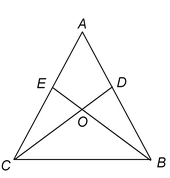
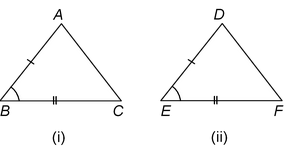
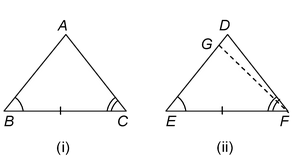
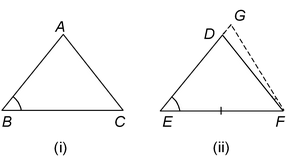
.png)
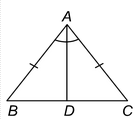

.png)
